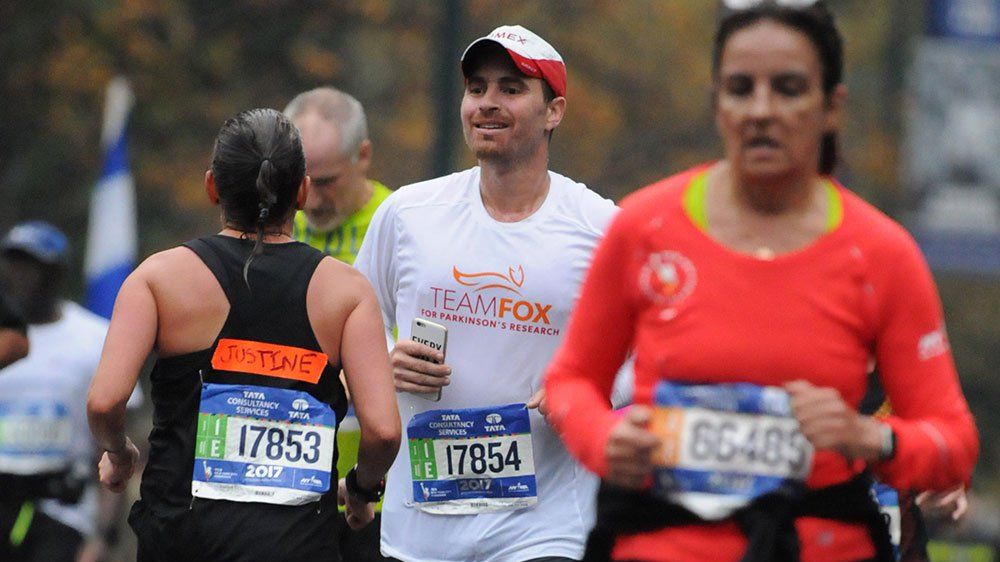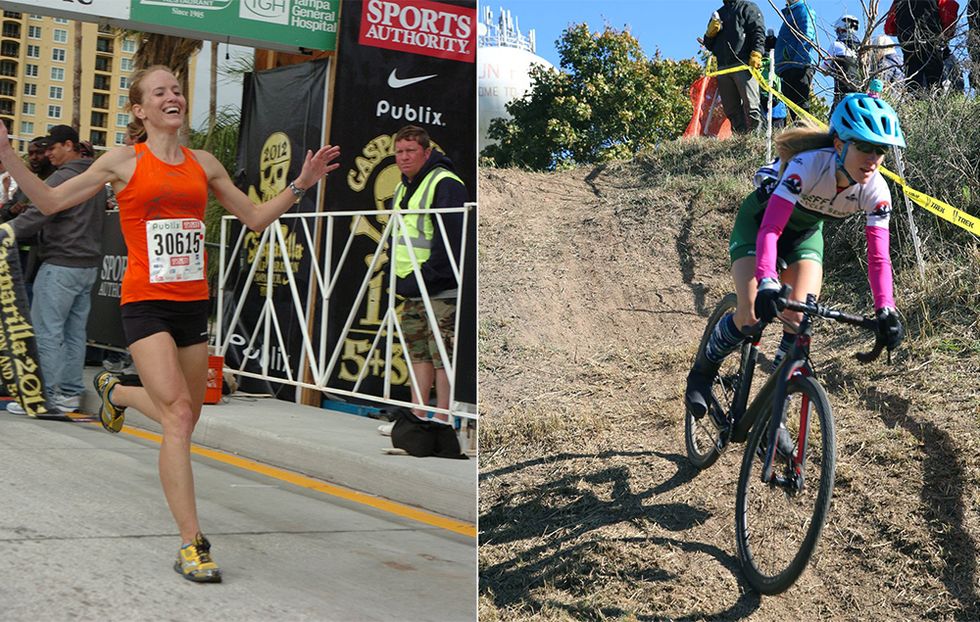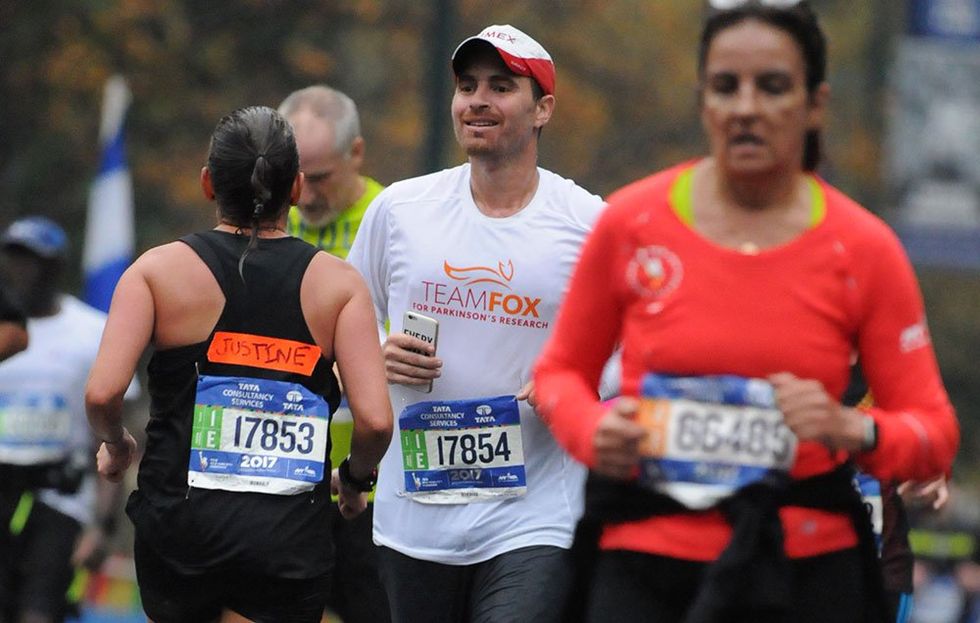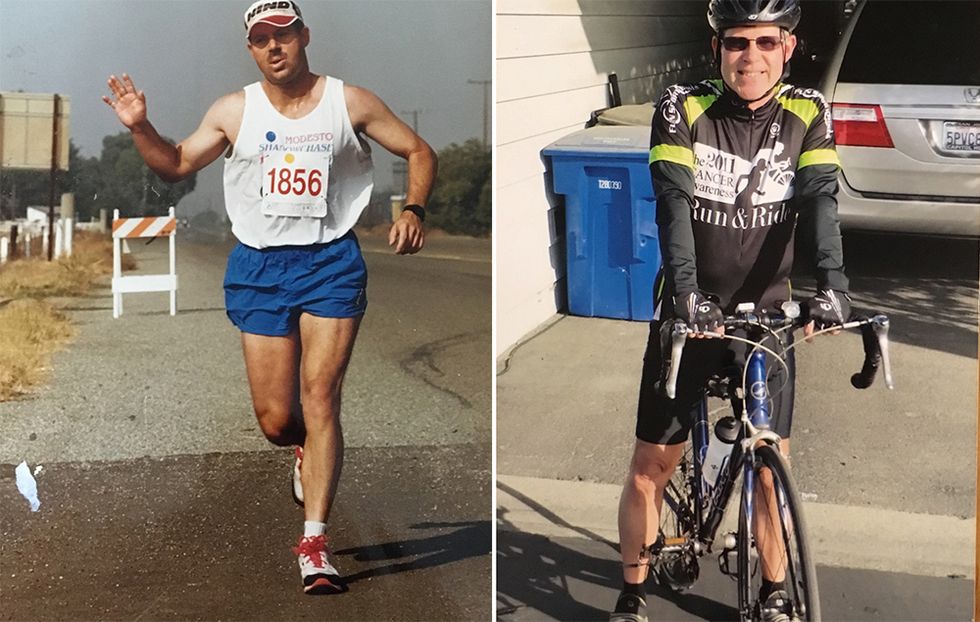Lee Tidball had always lived an active lifestyle, completing one marathon and countless shorter races, coaching youth teams, and logging thousands of miles on his road bike.
But around 2008, his right foot suddenly and repeatedly started slipping out of the toeclip on his bike and off the pedal of the elliptical machine at the gym. Eventually, when he ran or walked, his heel began to jerk backward instead of hitting the ground.
“I’d just kind of whiff instead of taking that step,” he says. At first, he thought his problems were linked to arthritis; an entry in his training log in 2009 reads: “Knee just won’t work right.” As his condition worsened, he retired from his career in teaching and moved to a one-story house to cope with his limited mobility.
Holly LaVesser, who ran in college at the University of Wisconsin-Whitewater, began noticing similar symptoms near the end of her longer runs about five years ago. “When I’d push off of my toe and need to bring my leg forward, it felt like there was a disconnect,” she says.
She changed her routine and cut her mileage, but after about two years, the sensation set in from the first few steps of every effort. Now, she’s largely shifted her athletic endeavors to cyclocross, off-road bike races. “I just don’t run anymore because feel like I can’t control my leg,” she says.
“I start doing what feels like swinging my leg out or galloping; it’s so unnatural.”
Marathoner Roberta Reardon first chalked up the “off” feeling she developed in her gait in 2010 to the slippery surfaces inherent to Canadian winter. But when she took a spring break trip from Ontario to Florida the next spring, her daughter instantly saw that her running looked wrong. “You almost feel like that leg is not really helping you propel forward—like it’s a hindrance,” Reardon says.
Each of these athletes traveled from orthopedist to physical therapist to neurologist and back for years. X-rays and MRIs offered few answers; cortisone shots and even surgeries, little relief. Potential explanations included everything from the terminal degenerative disease ALS to psychosomatic illnesses—physical manifestations of stress or anxiety.
In 2022, Olympian Kara Goucher shared with Runner’s World that all of these particular maladies were changing her outlook on running as well.
Eventually, they all received the same diagnosis: runner’s dystonia, a rare movement disorder that tends to affect the muscles in one leg. Essentially, brain signals controlling the muscles needed for running spill over into surrounding areas, activating muscles that work at cross purposes. “The result is the limb goes into a funny posture because too many muscles all fire together,” says Jeremy Cutsforth-Gregory, M.D., a movement disorders specialist at the Mayo Clinic in Rochester, Minnesota, and author of a research paper on the condition.
As a result of these spasms, runners’ ankles may lock up, their legs drag, their toes pull or cramp. What once seemed like an effortless stride now seems to require careful, conscious consideration of how to bring the troubled leg into proper position.
For a while, creative solutions can trick the brain’s circuits and bypass the issue. LaVesser contained her problem at first by running on trails rather than roads or treadmills; the varied surface seemed to help. Another runner with dystonia, Justine Galloway, found she could run backward—and in fact, recently completed the entire New York City Marathon this way.
But often, the condition progresses until the limb in question simply won’t comply. Within months or years, walking may grow increasingly difficult, as well.
There’s much scientists still don’t understand about how runner’s dystonia occurs and why it strikes some runners and not others with similar histories and habits. Treatment can involve ongoing injections, medications, and extensive visualization and management training. Even when it’s successful, runners with severe cases can’t always return to the sport.
Many, though, can resume other types of intense exercise—something that’s been critical for Tidball. Several years ago, he hobbled on crutches around the elementary school at which he taught physical education, among other subjects. He eventually started to receive regular injections of botulinum toxin (aka Botox) to relax the muscles in his affected leg, he hikes with his wife, walks 10 to 12 miles a week, and cycles 100.
“We’re talking radical, radical changes in lifestyle before they figured out I had dystonia and that there was something they could do about it,” he says. Unlike ALS, a diagnosis of dystonia isn’t fatal. “But I tell my doctors all the time, they saved my life.”
Who has runner’s dystonia?
At least per the medical literature, runner’s dystonia is exceedingly rare. The review and update Cutsforth-Gregory published in 2016 nearly doubled the number of reported cases, from 21 to 41. But movement disorder specialists like Maya Katz, M.D.,, who published one of the other few research papers on the topic in 2013, believe many more athletes are likely affected.
Anecdotal evidence backs this claim—and awareness seems to be growing. A thread on Letsrun.com message boards about “loss of coordination in leg” stretches more than 60 pages. LaVesser started a Facebook group that has more than 500 members, who commiserate, trade tips and links to blogs, and post videos of themselves stumbling on treadmills and around tracks.
Nate Jenkins, who placed seventh in the 2008 Olympic Trials Marathon with a personal-best 2:14:56, has struggled with what he calls coordination issues since shortly before that race. In fact, he writes on his meticulously kept training and racing blog, the problem has largely defined his running career. He first felt a disconnect in his right leg at the end of a hard workout in 2007, and eventually progressed to the point that he couldn’t run more than a 5K at marathon pace.
“It feels very neurological,” he says. “And it just seems awkward. You can’t even think through how you would make the bad leg do what it’s supposed to. It kind of buckles under you. It’s difficult balance-wise, and you don’t get much power out of it.”
Jenkins, who has been a teacher since 2012, when he lost his shoe contract, has tried just about anything he found and could afford. He labored to shift his gait, build strength, and activate muscles through weight training and bodywork. He’s had cortisone shots in his back and worn a harness-like vest on his shoulders to correct his posture. In 2011, he had surgery to fix a herniated disc, which he says seems to have stopped his condition from worsening.
But despite his public struggles and extensive consultations with various specialists about runner’s dystonia, he’d never heard the term “dystonia” until 2017, when another runner with similar issues mentioned the condition to him and his wife, Melissa. “We did some research and it was like, ‘Yep, yep, that’s it. That would be the problem,’” he says.
How is runner’s dystonia diagnosed?
Because runner’s dystonia is so rare, many doctors—especially sports medicine physicians and orthopedists, where runners often turn for sports injuries—have never seen a case. That makes Jenkins’s lengthy, frustrating road to find answers somewhat typical. On average, it takes runners with dystonia between two and three and a half years to receive an accurate diagnosis, research shows.
Along the way, some are misdiagnosed with conditions like compartment syndrome or tendon problems, for which they undergo unnecessary and potentially risky treatments. Tidball had surgery to remove a screw in his knee from a previous operation, which proved completely ineffective. LaVesser nearly scheduled an operation for iliac artery endofibrosis, a form of blood-vessel damage common to cyclists.
Runners also may be alternately told they’re just anxious—that the symptoms are all in their heads—or that they may have serious conditions like multiple sclerosis, ALS, or muscular dystrophy. When Reardon finally received a diagnosis of runner’s dystonia after five years, she felt relieved: “I had gone to some bad places with some of the other possibilities,” she says.
Blood tests, X-rays, MRIs, and other tests may be used to rule out similar conditions, but there’s no single scan or blood level that can definitively point to runner’s dystonia. An electromyography (EMG) test, which involves inserting needles into muscles to gauge their activity, often provides clues.
Katz says when patients walk into her office, she can make the diagnosis within five minutes by watching their gait and listening to their story. But she’s a highly trained specialist—and many runners likely give up before they reach a physician like her, part of the reason she believes the condition is underdiagnosed. “If they don’t have an astute orthopedist who realizes that is a neurological issue, they may never get a referral,” she says.
What’s the cause of runner’s dystonia?
Genes may play a role in why some runners develop the symptoms and others, who log many more miles, never do. Some—but not all—patients have family members with dystonia, Parkinson’s disease, or other neurological conditions.
In fact, similar symptoms can serve as an early warning sign of Parkinson’s disease, in which deficits in a brain chemical called dopamine interfere with proper movement. For this reason, many doctors advise trying a dopamine-boosting medication like levodopa first; if it works, the disorder is more likely to be Parkinson’s disease, Katz says.
Some people, like Reardon, recall a specific injury that predated their symptoms. Shortly before her symptoms appeared, she was dropped during an office team-building activity. While such complaints might be linked, the small number of cases doesn’t yet allow scientists to definitively point to them as predisposing factors, Cutsforth-Gregory says.
Though the “why” remains largely mysterious, scientists have started to understand how the condition unfolds. For some reason, wires become crossed deep down in the basal ganglia, a primitive area of the brain that plays a role in planning and executing movement. There, fibers parallel to each other control nearby muscles that allow you to perform similar activities.
“For normal action, you should be able to fire one and inhibit all the surrounding fibers. But if that’s impaired, you fire what you want, but you also fire the other stuff,” Cutsforth-Gregory says. “You end up with too many muscles contracting.” It’s almost like trying to text on a tiny keyboard using big fingers; the words get garbled, with no autocorrect to fine-tune them.
Similar, debilitating conditions called task-specific dystonias also affect practitioners of other pursuits, including musicians—drummers who can’t swing their sticks, oboists who lose control of their embouchure, guitar or piano players whose hands lock up. Writer’s cramp also falls into the same category, as do golfers’ yips. Cruelly, these disorders often strike top performers at their peak, locking up the precise muscles needed to pursue their craft.
Often, they can be addressed by changing something about the task—adjusting a grip on the golf club or the fit of a mouthpiece. With a sport like running, that’s much more difficult to do—but it explains why, for example, running backward might work. “It uses the same muscles as running forward but in a different order, different firing sequence,” Cutsforth-Gregory says.
How do you know if you have runner’s dystonia—and what should you do about it?
Red flags include symptoms of disconnection or lost coordination that occur only while running at first, Katz says, though they may eventually strike during walking. If they go away when you switch to new surfaces, run backward, or even just think about running backward, dystonia might be the cause. “There’s really nothing else that does that,” she says.
Any symptoms that sound similar and don’t improve with a few months of physical therapy or other treatments could be dystonia, Cutsforth-Gregory says. He recommends specifically requesting a referral to a movement disorder specialist.
Right now, dystonia can’t be cured, but doctors do have ways to manage symptoms. Drugs that prevent seizures or relax muscles may help, but often, the doses required to ease the spasms are so high they cause severe side effects.
So they may be used in combination with regular injections of Botox like the ones Tidball receives, which essentially jam the network. “The brain is saying, contract, contract, contract,” Katz says, “but Botox blocks that signal from the nerve to the muscle.”
The shots are administered in a precisely calibrated pattern—guided by the EMG machine that reads electrical signals—tailored to target each patient’s overactive muscles with the precise dose of the toxin needed. (Everyone responds a little differently.) For Tidball, getting the exact protocol dialed in took about a year and a half.
He would drive 90 miles from his home in Modesto to San Francisco every two and half months, where Katz injects eight doses of the toxin into his legs. It's not exactly convenient or easy—but worth it. Overall, he feels about 90 to 95 percent better, he reports.
Botox does have its risks. Though it’s rare, a black-box warning advises that some patients have died when the toxin spread to breathing and swallowing muscles. If the dosage isn’t just right, muscles can over-weaken, making walking difficult again until the toxin wears off, Katz says.
And it doesn’t work for everyone. In utsforth-Gregory’s paper, four of seven patients who tried it had benefits, though Katz saw success in six of the seven patients treated with it in her case series.
Many runners, who either didn’t see success with traditional treatments or are wary of injections, consider other options. Some have sought help from Joaquin Farias, Ph.D., a lecturer in music and health sciences at the University of Toronto who administers a protocol he calls the Farias Technique, which he says can complement medical treatment for dystonia or serve as a natural alternative.
During four-day workshops, most held in Toronto, he guides patients through an extensive education program that includes exercises to stimulate their natural walking and running reflexes; visualizations aimed at retraining the brain; and instruction on how to spot the early warning signs of an oncoming episode and avert them through movement and breathing drills.
Though she hadn’t heard of Farias’s program, Katz says she’s open to new therapies, especially ones that can be proven effective. Other types of intense visualizations or sensorimotor retraining programs for dystonias have some support in research. This approach would require significant dedication and hard work over time—but then again, so does running. “I think runners are a specifically highly focused group, so I think probably it would work the best for that group,” Katz says, though she notes they’re not currently often used in mainstream medicine.
Doctors are also exploring ways of intercepting nerve impulses with deep brain stimulation—surgery to implant electrodes deep within a part of the basal ganglia called the globus pallidus. Last year, researchers in Utah reported a case of a runner who was once relegated to walking only with crutches but began running again for the first time in four years after the operation. Cutsforth-Gregory says his team has also seen good results in a patient following this surgery, and hopes to report them in a medical journal soon. “It’s one ray of light,” he says, in a literature that otherwise is somewhat limited in hope.
For runners like Reardon, hope plays a key role in coping with dystonia’s effects. She attended one of Farias’s workshops in October and found the exercises useful, and his words about the possibility for at least partial improvement inspiring. “Belief is integral to recovery,” she says. “Believing that it can change for the better has helped me trust in my capacity to improve.”
After a series of activation exercises, Reardon could run about three to four miles, especially if she incorporates faster intervals. Using a metronome or watching her running partners helps her keep her rhythm. Sometimes she even feels her left leg “switch on” again: “It’s such a great feeling—like, whoa, I got double power here.”
Though she was not certain she’d be able to return to the 50-mile marathon-training weeks of her past, she aims to try for at least a 10K or a half—and she’s building an entire treatment team to support her, including a strength and conditioning coach, movement and dance instructor, and physiotherapist, along with a counselor to help her in times where she feels her mood sinking. “Anybody who does endurance running, that’s probably a big part of the way they live their life—and this is a huge lifestyle change,” she says. “Know that it’s a normal thing, to have depression with that, and talking to someone about it really does help.”

Cindy is a freelance health and fitness writer, author, and podcaster who’s contributed regularly to Runner’s World since 2013. She’s the coauthor of both Breakthrough Women’s Running: Dream Big and Train Smart and Rebound: Train Your Mind to Bounce Back Stronger from Sports Injuries, a book about the psychology of sports injury from Bloomsbury Sport. Cindy specializes in covering injury prevention and recovery, everyday athletes accomplishing extraordinary things, and the active community in her beloved Chicago, where winter forges deep bonds between those brave enough to train through it.

















